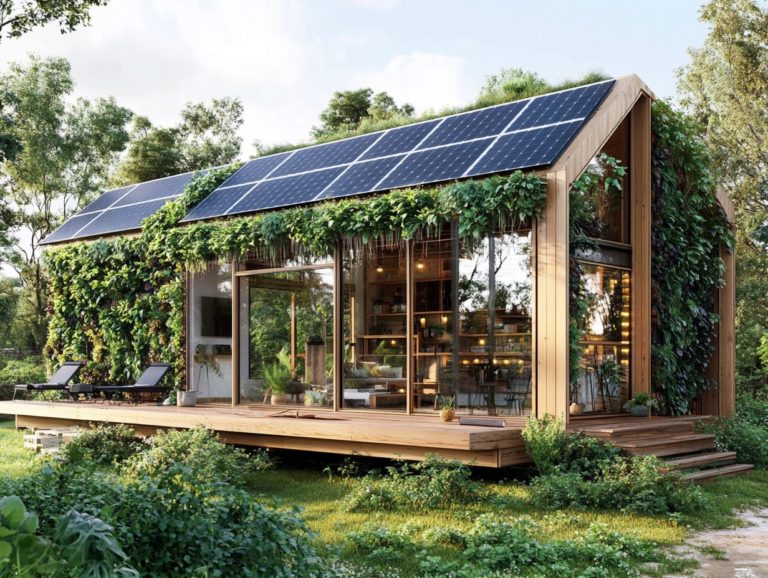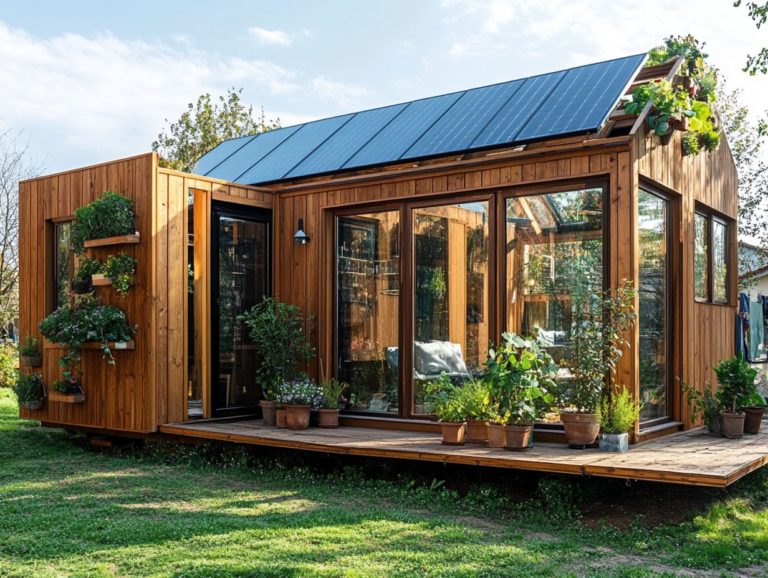How to Assess the Sustainability of Building Materials
As you navigate the complexities of our environmental landscape, selecting building materials is a pivotal decision.
Choosing sustainable building materials benefits the planet and fosters community well-being, bolsters economic stability, and promotes a circular economy.
This exploration delves into the myriad advantages these materials offer, outlines criteria for assessing their sustainability, and introduces effective evaluation tools, including green certifications.
From harnessing renewable resources to embracing innovative technologies, you ll find compelling examples and insights into the challenges that may arise in their implementation. This knowledge empowers you to make informed choices that pave the way for a greener future.
Contents [hide]
- Key Takeaways:
- The Importance of Sustainable Building Materials
- Criteria for Assessing Sustainability
- Tools and Methods for Evaluating Sustainability
- Examples of Sustainable Building Materials
- Implementing Sustainable Materials in Construction
- Frequently Asked Questions
- What is the definition of sustainability in terms of building materials?
- Why is it important to assess the sustainability of building materials?
- What should I think about when assessing sustainability?
- How can I determine the environmental impact of a building material?
- What are some certifications or labels that indicate the sustainability of building materials?
- Can I assess the sustainability of building materials on my own?
Key Takeaways:

Sustainable building materials actively benefit both the environment and society by reducing negative impacts and promoting positive change.
To assess sustainability, consider environmental and social impacts, as well as economic viability.
Tools like life cycle assessment (LCA), which analyzes the environmental impact of materials throughout their life, and important certifications for sustainable building materials can help evaluate the sustainability of building materials while promoting environmental consciousness.
The Importance of Sustainable Building Materials
Sustainable building materials are essential in construction, as they significantly reduce environmental impact while championing eco-friendly practices. These materials, sourced from renewable resources, minimize carbon emissions and contribute to a healthier planet.
Using sustainable materials supports eco-friendly practices and enhances indoor air quality, promoting the well-being of those who inhabit your spaces. It also aligns with principles of resource management, underscoring their vital role in contemporary architectural engineering.
Benefits for the Environment and Society
Adopting sustainable building materials provides a wealth of benefits for both the environment and society. It significantly enhances indoor air quality and reduces waste in construction practices.
When you choose eco-friendly construction, you contribute to a smaller carbon footprint. Research indicates that buildings constructed with sustainable practices can reduce greenhouse gas emissions by up to 30%. By managing resources wisely through reclaimed or locally sourced materials, you help preserve finite resources and bolster local economies.
Residents in eco-friendly buildings often report improved health outcomes, such as reduced respiratory issues and overall enhanced well-being, thanks to better indoor air quality. Communities that embrace these practices typically enjoy improved living conditions, with evidence showing that neighborhoods focused on environmental sustainability tend to have increased property values and greater overall satisfaction among residents.
Criteria for Assessing Sustainability
Assessing the sustainability of building materials requires a thorough evaluation of various criteria, including their environmental impact, compliance with green building standards, and economic viability. These factors serve as essential guidelines for you, as an architect or builder, to select materials that fulfill ethical and ecological standards while exhibiting transparency and durability throughout their life cycle.
Start choosing sustainable materials today for a brighter tomorrow!
Environmental Impact
The environmental impact of building materials is a crucial consideration, directly tied to carbon emissions and resource depletion. This highlights the need for adopting biodegradable products and sustainable harvesting practices.
Traditional materials like concrete and steel have alarming consequences: habitat destruction, soil erosion, and increased greenhouse gas emissions. These operations disrupt local ecosystems, jeopardizing biodiversity and reshaping natural landscapes.
Choosing eco-friendly alternatives not only shrinks your carbon footprint but also nurtures a healthier environment. Sustainable materials require less energy to produce and last longer, ultimately reducing waste.
By implementing rigorous emissions testing and seeking third-party certification, you can ensure that sustainability claims are credible. This promotes product transparency within the building sector and paves the way for innovative, greener solutions.
Social Impact

The social impact of sustainable building materials extends beyond aesthetics; it significantly enhances health benefits and improves indoor air quality for residents. By implementing green building standards, you foster a deeper sense of community engagement and awareness regarding sustainable practices.
When you embrace these materials in your community, you re not just creating safer living spaces; you re igniting a shared commitment to sustainability! For example, a neighborhood that renovated its homes with bamboo floors and low-VOC paints reported fewer respiratory issues and an overall boost in well-being.
This transformation sparked vibrant discussions around eco-friendly initiatives, leading to more community garden projects and educational workshops on sustainable living. As individuals became more mindful of their consumption choices, public perception shifted regarding the importance of sustainable practices and their direct impact on community health and cohesion.
Economic Viability
The economic viability of sustainable building materials is best assessed through their total costs over the life of the material, factoring in potential tax rebates, operational efficiency, and long-term energy savings.
By examining the long-term financial benefits, you can uncover substantial savings linked to reduced energy consumption and lower maintenance expenses. Sustainable materials typically require less energy to produce and maintain, resulting in lower utility bills for occupants.
Achieving recognized building certifications enhances your property s market appeal, attracting eco-conscious buyers.
These certifications often unlock various funding opportunities, allowing you to invest more in green materials while ensuring a healthier return on investment. Ultimately, strategically utilizing sustainable resources supports your environmental objectives and cultivates a robust financial future.
Tools and Methods for Evaluating Sustainability
Evaluating sustainability in construction requires a sophisticated approach, utilizing a range of tools and methods. Life Cycle Assessment (LCA) evaluates the environmental impact of materials from production to disposal and stands out as a pivotal technique. Additionally, green building certifications offer structured frameworks to assess the environmental product declarations of sustainable building materials.
By employing these methods, you can ensure a comprehensive understanding of sustainability in your construction projects.
Life Cycle Assessment
Life Cycle Assessment (LCA) is an essential tool for evaluating the environmental impact of sustainable building materials. It offers valuable insights into resource management and the durability of materials throughout their entire life cycle.
Let s kick things off by exploring raw material extraction. This phase involves analyzing the environmental repercussions of sourcing those materials.
Next, we delve into the production phase, where we assess the processes that turn raw materials into usable products. Here, we highlight energy consumption and emissions generated during manufacturing.
After production, we consider the use phase. This evaluation includes how these materials perform in real-world conditions, focusing on their durability and energy efficiency (which means using less energy to perform the same task) over time.
Finally, the disposal phase tackles end-of-life considerations, assessing how materials can be recycled or disposed of responsibly.
By thoroughly examining these phases, you empower yourself and your organization to make informed choices about sustainable building materials. These choices not only help reduce your carbon footprint but also enhance overall environmental sustainability.
Green Building Certifications
Green building certifications, such as:
- Leadership in Energy and Environmental Design (LEED)
- Building Research Establishment Environmental Assessment Method (BREEAM)
- National Green Building Standard (NGBS)
These certifications are essential benchmarks for evaluating sustainable practices when selecting building materials and overseeing construction processes.
They not only elevate the marketability of properties but also instill best practices that contribute to environmental conservation. By adhering to these guidelines, you can significantly reduce your ecological footprint, improve indoor air quality, and implement energy-efficient technologies.
These certifications foster transparency and accountability. This ensures that you, as a developer or client, are committed to responsible building practices that can profoundly impact our shared environment.
Join the movement towards sustainable construction today!
Examples of Sustainable Building Materials

Sustainable building materials come in a rich variety, from natural and recycled options to cutting-edge technologies that emphasize eco-friendliness. Think of bamboo and other renewable resources that not only enhance your projects but also reflect a commitment to environmental stewardship.
Natural and Recycled Materials
Natural and recycled materials, such as reclaimed wood and recycled steel, are prime examples of sustainable building choices. They significantly lessen environmental impact while ensuring both durability and aesthetic appeal.
Take reclaimed wood, for instance. It often originates from old barns or industrial buildings, allowing you to repurpose it instead of sending it to the landfill. This approach helps combat deforestation and preserves the rich character and history embedded in the wood.
On the other hand, recycled steel, sourced from scrap metal, reduces the need for new steel production an endeavor that requires a lot of energy. It offers a remarkable strength-to-weight ratio, ensuring your structures remain solid yet lightweight.
When comparing these options to conventional materials like new lumber or virgin steel, which demand substantial natural resources and carry a larger carbon footprint, it’s clear that embracing natural and recycled materials is a smarter, more sustainable choice for any forward-thinking construction project.
Innovative Technologies
Innovative technologies in sustainable building materials, including advanced curing techniques and prefabrication methods, significantly enhance eco-friendly construction processes and improve overall building performance.
These cutting-edge technologies streamline your construction timelines and minimize waste generation. They also reduce energy consumption at the job site. For instance, 3D printing is revolutionizing the industry by allowing for the creation of intricate building components with remarkable precision. This leads to less material wastage.
Using recycled materials in modular construction showcases how you can actively contribute to circular economy practices. By harnessing renewable energy sources, such as integrating solar panels into your building designs, you achieve impressive levels of energy efficiency.
As these innovative solutions continue to advance, they play a pivotal role in helping you create structures that are both environmentally responsible and cost-effective over time.
Implementing Sustainable Materials in Construction
Implementing sustainable materials in construction may present unique challenges. However, you can develop effective solutions through refined construction practices and strategic resource management.
Embrace these approaches to transform your projects and make a real difference! Not only do they enhance your projects, but they also contribute to a more eco-friendly future.
Challenges and Solutions
The challenges you face when adopting sustainable materials often stem from cost-effectiveness, availability, and the need to shift traditional construction practices.
These hurdles can create significant barriers for architects, engineers, and builders who are eager to innovate and contribute to a greener planet. The limited availability of sustainable options, combined with the perception of higher costs, can deter stakeholders from making the switch.
To navigate these obstacles, it’s crucial to advocate for policy changes that offer financial incentives for using eco-friendly materials. Highlighting successful case studies can serve as valuable references, illustrating how sustainable practices not only benefit the environment but also lead to long-term economic savings and improved building performance.
Frequently Asked Questions

What is the definition of sustainability in terms of building materials?
Sustainability in building materials refers to the use of materials that have a minimal negative impact on the environment and society, both during their production and throughout their lifespan.
Why is it important to assess the sustainability of building materials?
Assessing the sustainability of building materials allows us to make informed decisions that can reduce our environmental impact and promote a more socially responsible approach to construction.
What should I think about when assessing sustainability?
Factors to consider include the source and extraction of the materials, their manufacturing processes, durability, energy efficiency, and potential for reuse or recycling.
How can I determine the environmental impact of a building material?
One way to determine the environmental impact is by looking at its life cycle assessment. This considers its impact from raw material extraction, transportation, manufacturing, use, and disposal.
What are some certifications or labels that indicate the sustainability of building materials?
Certifications and labels such as LEED, Green Globes, and Cradle to Cradle indicate sustainability by evaluating the environmental and social impact of building materials.
Can I assess the sustainability of building materials on my own?
While it may be challenging to assess the sustainability of building materials yourself, tools and guides are available to help you make more informed decisions.
Explore sustainable building practices or get involved in local initiatives to make a difference!






